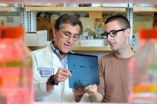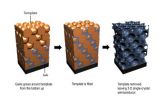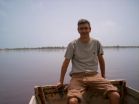(Press-News.org) A genome-wide association study published in the August issue of Nature Medicine has found two tiny genetic variations that can predict which patients with Hodgkin's lymphoma are most likely to develop radiation-induced second cancers years after treatment. Knowing in advance who is at risk could help physicians tailor treatment to reduce the risks for patients who are most susceptible to long-term damage.
Hodgkin's lymphoma is one of the most treatable cancers, with more than 90 percent of patients surviving after a combination of radiation and chemotherapy. But nearly 20 percent of patients treated as children develop a second cancer within 30 years. The younger the patients are when treated and the higher the radiation dose, the greater the risk. This late side effect of treatment is the second leading cause of death for long-term Hodgkin's survivors.
"This finding means we can better identify children who are most susceptible to radiation-induced cancers before treatment begins and modify their care to prevent this serious long-term complication," said Kenan Onel, MD, PhD, associate professor of pediatrics and senior author of the study. "Luckily our options for Hodgkin's are broad enough that we can find ways to control the initial disease without relying on radiation therapy."
"This is also a triumph for genome-wide association studies," he added. "Many previous GWAS studies found multiple genetic differences, with each of them playing only a modest role, with minimal impact on clinical management. In this study, which focused on the interaction between genes and a very specific environmental factor—cancer long after radiation therapy—a small number of genetic differences produced a very big impact."
Onel and colleagues analyzed the genomes of 178 Hodgkin's patients who had been treated between the ages of 8 and 20 with chemotherapy and radiation therapy. Within 30 years after treatment, 96 of them had developed second cancers and 82 had not.
When they scanned each patient's genome, focusing on 665,313 tiny genetic variations known as single nucleotide polymorphisms, they found three variations that appeared far more often in patients with second cancers. When they repeated the study using a different set of patients—62 cases with second cancers and 71 without—two of the three markers were significant.
Those two markers were both from a small region known as 21q on chromosome 6. Both are positioned near a gene known as PRDM1.
The genetic variations closely associated with increased cancer risk, and with each other, appeared to decrease activation of the PRMD1 gene. They had no detectable effect any other genes. Cells with the protective version of both markers expressed PRDM1 after being exposed to radiation. Cells with the variants linked to subsequent cancers did not produce any PRDM1.
Previous studies have found that PRDM1 is involved in a variety of fundamental cellular processes, including proliferation, differentiation and apoptosis—which can all go awry in cancer. The gene's activity is lost in many cancer types.
In Onel's small samples, only three percent of patients with both of the protective variants developed second cancers within 30 years; nearly 33 percent of those with both of the high-risk variations did.
"Taken together," the authors note, "our findings support a novel role for PRDM1 as a radiation-responsive tumor suppressor." PRMD1 may be important for understanding the causes of second cancers in survivors of pediatric Hodgkin's lymphoma as well as in other cancer patients treated with radiation therapy."
This study should also "bring some optimism" back to genome-wide association studies, Onel added. Most previous cancer-related markers found through GWAS have been "of little clinical value for predicting risk, response to therapy or survival." But by incorporating environmental exposure, such as radiation therapy, into genomic investigations, "much of the missing heritability can be revealed," he said. "By folding in the environmental component, we were able to ask a more targeted question. This approach could improve our ability to integrate genomics into routine cancer care."
INFORMATION:
The National Institutes of Health, the American Cancer Society, American Lebanese Syrian Associated Charities, the Leukemia Lymphoma Society, the Breast Cancer Research Foundation, the Cancer Research Foundation, and the University of Chicago Comprehensive Cancer Center supported this research.
Additional authors include Timothy Best, Andrew Skol, Sarah Jackson, Olufunmilayo Olopade and Stephanie Huang of the University of Chicago; Dalin Li, Thomas Mack, Wendy Cozen and David Conti of University of Southern California; Kenneth Offit and Thomas Kirchhoff of Memorial Sloan Kettering Cancer Center; Yutaka Yasui of the University of Alberta; Smita Bhatia of City of Hope; Louise Strong of the MD Anderson Cancer Center; Susan Domchek and Katherine Nathanson of the University of Pennsylvania; and Leslie Robison of St Jude Children's Research Hospital.
2 genetic variations predict second cancers after radiation for children with Hodgkin lymphoma
2011-07-25
ELSE PRESS RELEASES FROM THIS DATE:
Graphene's 'quantum leap' takes electronics a step closer
2011-07-25
Writing in the journal Nature Physics, the academics, who discovered the world's thinnest material at The University of Manchester in 2004, have revealed more about its electronic properties.
Research institutes and universities around the world are already looking at ways to build devices such as touch-screens, ultrafast transistors and photodetectors.
Now the research from the creators of the material promises to accelerate that research, and potentially open up countless more electronic opportunities.
The researchers, from the universities of Manchester, Madrid ...
Pocket chemistry: DNA helps glucose meters measure more than sugar
2011-07-25
CHAMPAIGN, Ill. — Glucose meters aren't just for diabetics anymore. Thanks to University of Illinois chemists, they can be used as simple, portable, inexpensive meters for a number of target molecules in blood, serum, water or food.
Chemistry professor Yi Lu and postdoctoral researcher Yu Xiang published their findings in the journal Nature Chemistry.
"The advantages of our method are high portability, low cost, wide availability and quantitative detection of a broad range of targets in medical diagnostics and environmental monitoring," Lu said. "Anyone could use it ...
New photonic crystals have both electronic and optical properties
2011-07-25
CHAMPAIGN, Ill. — In an advance that could open new avenues for solar cells, lasers, metamaterials and more, researchers at the University of Illinois have demonstrated the first optoelectronically active 3-D photonic crystal.
"We've discovered a way to change the three-dimensional structure of a well-established semiconductor material to enable new optical properties while maintaining its very attractive electrical properties," said Paul Braun, a professor of materials science and engineering and of chemistry who led the research effort.
The team published its advance ...
Epigenetic 'memory' key to nature versus nurture
2011-07-25
Researchers funded by the Biotechnology and Biological Sciences Research Council (BBSRC) at the John Innes Centre have made a discovery, reported this evening (24 July) in Nature, that explains how an organism can create a biological memory of some variable condition, such as quality of nutrition or temperature. The discovery explains the mechanism of this memory – a sort of biological switch – and how it can also be inherited by offspring.
The work was led by Professor Martin Howard and Professor Caroline Dean at the John Innes Centre, which receives strategic funding ...
Soft spheres settle in somewhat surprising structure
2011-07-25
Latex paints and drug suspensions such as insulin or amoxicillin that do not need to be shaken or stirred may be possible thanks to a new understanding of how particles separate in liquids, according to Penn State chemical engineers, who have developed a method for predicting the way colloidal components separate based on energy.
"The ongoing assumption was that if you have a mixture of different sized particles in a liquid, the faster-settling particles will end up on the bottom," said Darrell Velegol, professor of chemical engineering. "We found that in many cases it ...
Mismatch between cancer genetics counseling and testing guidelines and physician practices
2011-07-25
A new analysis has found that many doctors report that they do not appropriately offer breast and ovarian cancer counseling and testing services to their female patients. Published early online in CANCER, a peer-reviewed journal of the American Cancer Society, the study indicates that efforts are needed to encourage these services for high-risk women and discourage them for average-risk women.
Women with mutations in the BRCA1 or BRCA2 gene have a substantially increased risk of developing breast and ovarian cancer, but there are medical treatments that can dramatically ...
Children eating more, and more frequently outside the home
2011-07-25
Philadelphia, PA, July 25, 2011 – As childhood obesity rises and the American diet shifts towards increasing consumption of foods eaten or prepared outside of the home, concerns about the nutritional quality and the total consumption of such foods are also increasing. According to a study conducted at the University of North Carolina at Chapel Hill and published in the August 2011 issue of the Journal of the American Dietetic Association, eating location and food source significantly impact daily energy intake for children. Foods prepared away from home, including fast ...
Catching the West Nile virus in action
2011-07-25
Tel Aviv — Since 1999, several outbreaks of West Nile Virus, which causes fever or severe neurological symptoms and is transmitted from birds to humans by blood-sucking mosquitoes, have been seen in the U.S., usually during the summer months. But researchers aren't certain how the virus migrated here — and they don't know how, or where, it will appear next.
Now Prof. Ella Mendelson of Tel Aviv University's School of Public Health at the Sackler Faculty of Medicine, working with the Israeli Ministries of Health and Environment, has instituted a study that tracks both clinical ...
Double jeopardy: Tuna and billfish
2011-07-25
MIAMI – July 25, 2011 – A new study by top global fisheries experts presents an alarming assessment of several economically important fish populations. The analysis of 61 species of "scombrids," which include tunas, bonitos, mackerels and Spanish mackerels, and billfishes, which include swordfish and marlins, classified seven as threatened with extinction and four as "near threatened" for the IUCN Red List of Threatened Species.
University of Miami Rosenstiel School of Marine & Atmospheric Science associate professor, and assistant director of NOAA's Cooperative Institute ...
Pekasus, Factory of Animated Dreams, Today Announces the Publication of its Newest Book in its Ongoing Series, Spark the Stone Man
2011-07-25
The book's 16 full-color illustrations are the handiwork of British Academy Award recipient and Oscar nominee, Olga Titova. Another key participant in the project is Aida Zyablikova, a movie director and a British Academy Award recipient and Oscar nominee.
Asya Pekurovskaya says there will eventually be six books in the Spark's series. Two have now been published and two more are waiting in the wings. She is currently at work finishing the final two. Each book, she says, stands on its own but also builds upon earlier books and the Spark the Stone Man cosmology. The entire ...





